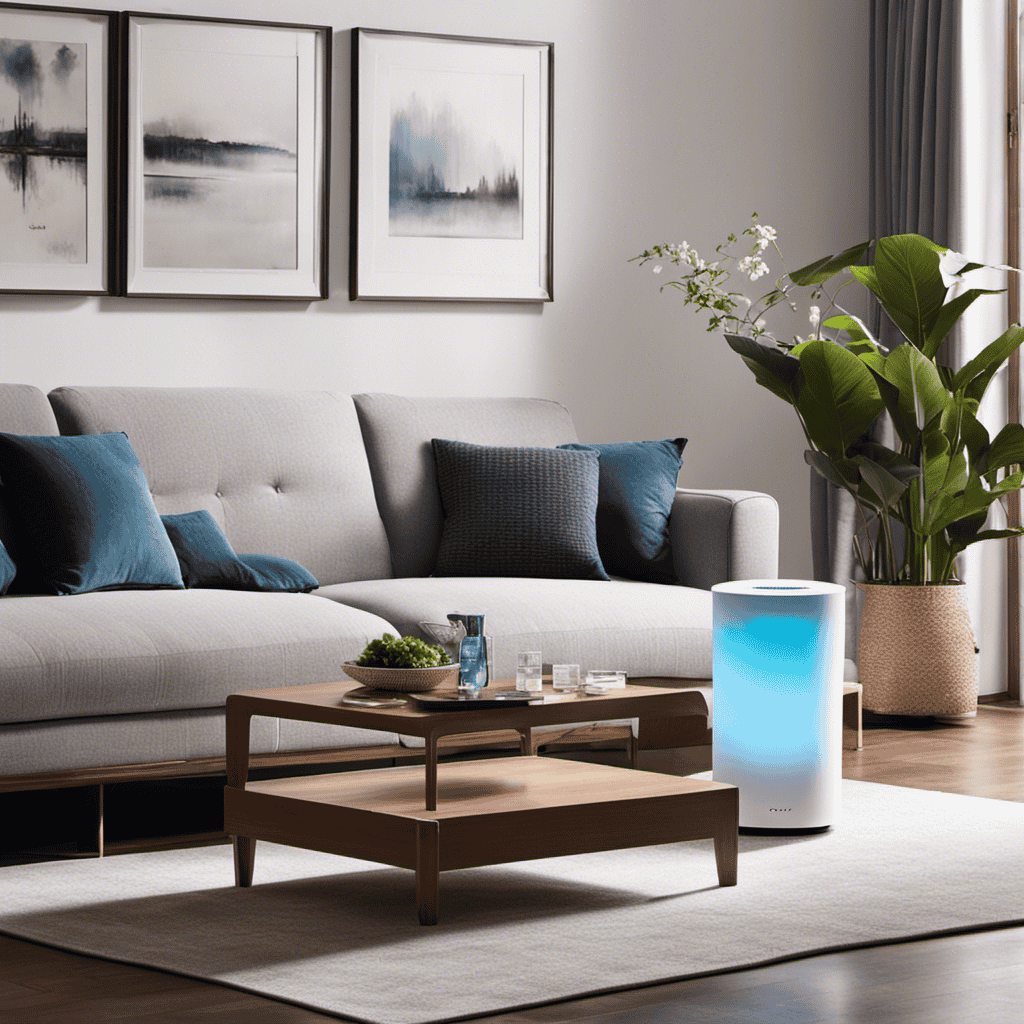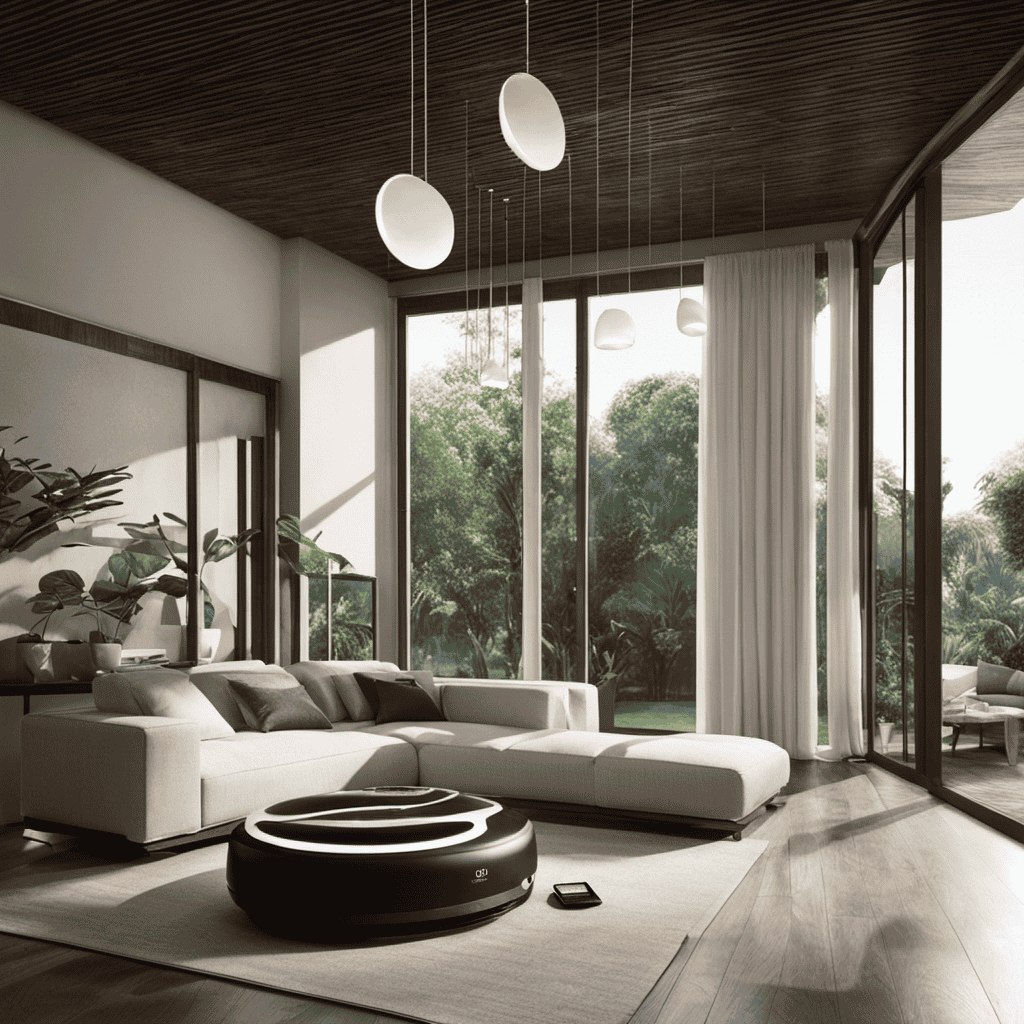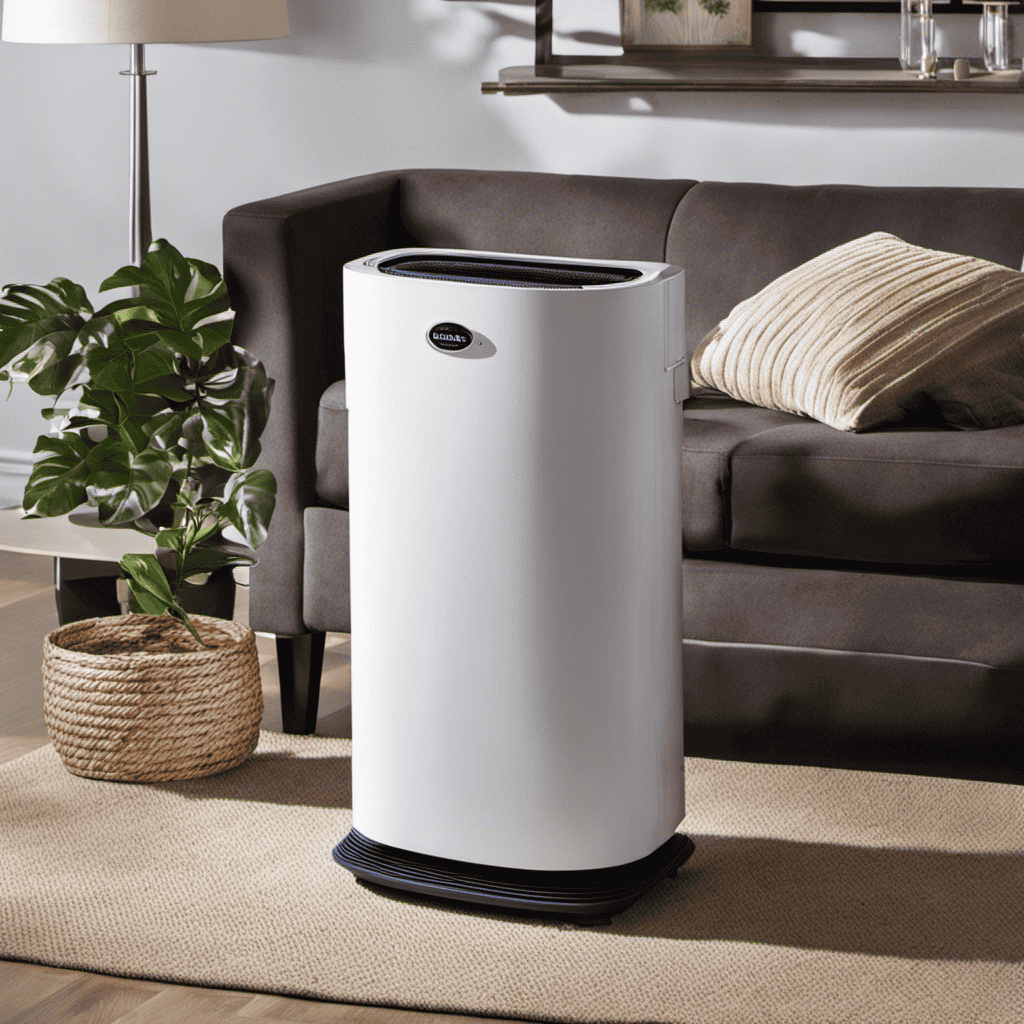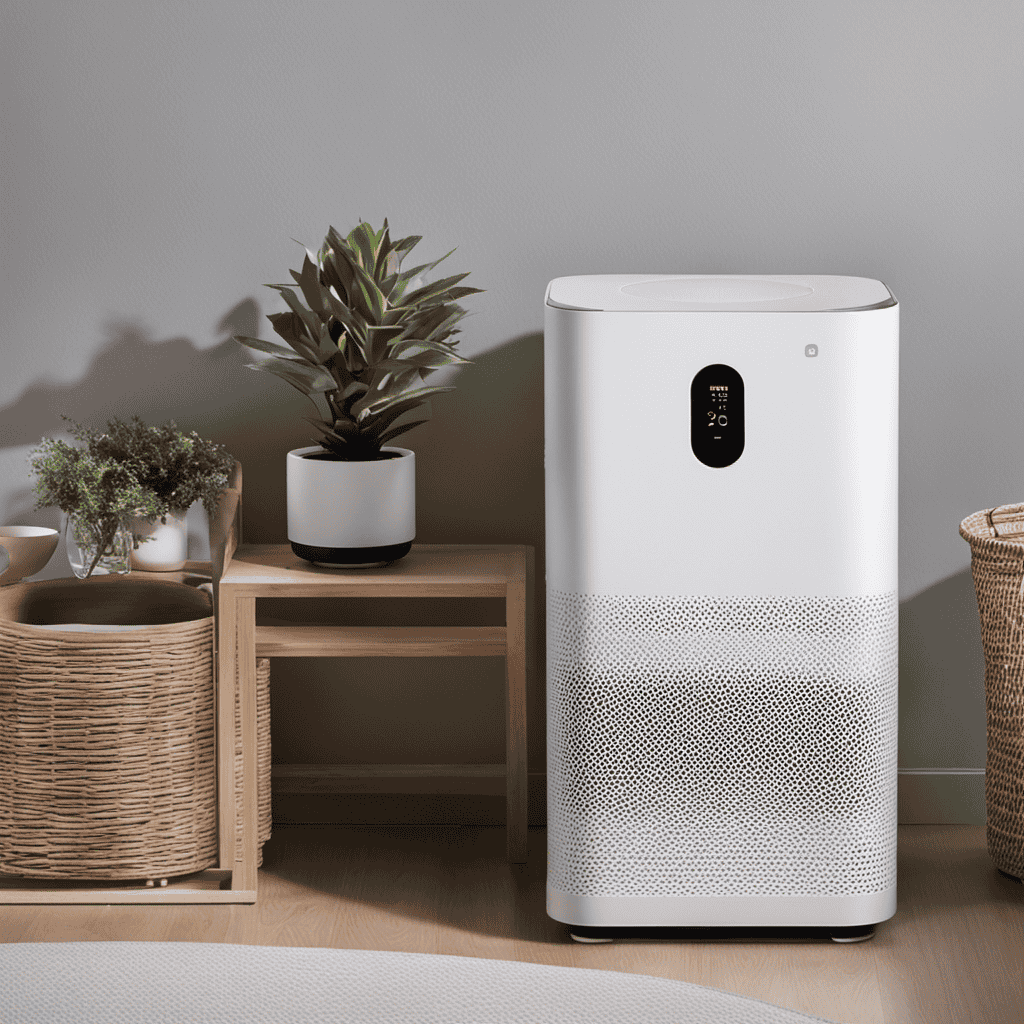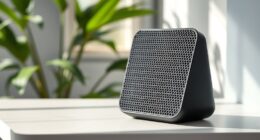I’ve always believed that clean air is the key to a healthy and comfortable living space. That’s why I recently got my hands on the Coway AP-1512HH Mighty Air Purifier. Let me tell you, it’s a game-changer!
In this article, I’ll guide you through the ins and outs of using this incredible device. From unboxing to understanding the control panel, adjusting fan speed to replacing filters – I’ve got you covered.
Get ready to breathe in pure, fresh air like never before.
Key Takeaways
- Adjust fan speed and airflow control using the control panel
- Use the timer function to schedule purifier operation and save energy
- Regularly replace filters to maintain optimal performance and clean air
- Monitor the air quality indicator for real-time information and adjust settings accordingly
Unboxing and Initial Setup
Before you start using the Coway AP-1512HH Mighty air purifier, unbox it and complete the initial setup.
The first step is to carefully remove the packaging and take out all the components included in the box. Make sure to keep the user manual and warranty information handy for future reference.
Next, locate the filter compartment on the back of the unit and open it by pressing the latch. Insert the provided filter, making sure it fits securely. Close the compartment and plug in the purifier.
The control panel on the front allows you to adjust the fan speed and set the timer.
If you encounter any issues during the setup process, refer to the troubleshooting guide in the user manual for assistance.
Understanding the Control Panel
To adjust the settings on the control panel, simply press the desired buttons. The Coway AP-1512HH Mighty Air Purifier comes with a user-friendly control panel that allows you to customize your air purifying experience.
Here are some key features and functions you can access through the control panel:
-
Adjusting Fan Speed: With the touch of a button, you can easily increase or decrease the fan speed to match your preferences. This allows you to control the airflow and noise level of the purifier.
-
Using the Timer: The timer function allows you to set a specific duration for the purifier to operate. This is useful if you want the purifier to automatically turn off after a certain period of time, such as when you go to bed or leave the house.
-
Filter Replacement Indicator: The control panel also includes an indicator that alerts you when it’s time to replace the filters. This ensures that your purifier is always working at its best.
-
Auto Mode: By selecting the auto mode, the purifier will automatically adjust the fan speed based on the air quality in the room. This ensures optimal performance while saving energy.
-
Child Lock: The control panel also features a child lock function to prevent accidental changes to the settings. This is especially useful if you have young children or pets who may be curious about the purifier.
Overall, the control panel of the Coway AP-1512HH Mighty Air Purifier provides you with easy access to various functions, allowing you to personalize your air purifying experience. Whether you want to adjust the fan speed or set the timer, this control panel makes it simple and convenient to use.
Adjusting Fan Speed and Airflow
You can easily adjust the fan speed and airflow to your liking by pressing the desired buttons on the control panel. The Coway AP-1512HH Mighty Air Purifier offers multiple fan speed options and airflow control settings to cater to your specific needs. The control panel features intuitive buttons that allow you to effortlessly customize the fan speed and airflow level.
Here is a table that illustrates the different fan speed options and corresponding airflow control settings:
| Fan Speed | Airflow Control |
|---|---|
| Low | Gentle |
| Medium | Moderate |
| High | Powerful |
Using the Timer and Sleep Mode
If you want to set a timer or activate sleep mode, simply press the corresponding buttons on the control panel.
Using the sleep mode and timer on the Coway AP-1512HH Mighty Air Purifier offers several benefits:
-
Energy-saving: The timer allows you to set a specific time for the air purifier to turn on or off, helping you save energy and reduce electricity costs.
-
Convenience: By setting a timer, you can schedule the air purifier to automatically start or stop at desired times, ensuring optimal air quality in your home.
-
Noise reduction: The sleep mode is designed to operate the air purifier at a lower fan speed, making it quieter during nighttime use, promoting better sleep.
-
Customization: With the timer and sleep mode, you have the flexibility to adjust the air purifier’s settings according to your preferences and lifestyle.
-
Peace of mind: Using the sleep mode and timer allows you to enjoy clean and fresh air without worrying about manually operating the air purifier at all times.
Replacing the Filters
When it comes to replacing the filters in the Coway AP-1512HH Mighty Air Purifier, there are a few key points to consider.
First, it’s important to know the lifespan of the filters and when they need to be replaced.
Secondly, proper filter installation is crucial to ensure optimal performance of the air purifier.
Lastly, finding and sourcing replacement filters can be done through authorized retailers or directly from the manufacturer.
Filter Lifespan and Replacement
The filter lifespan of the Coway AP-1512HH Mighty air purifier is determined by the level of air pollution in your environment. Regular filter maintenance is crucial for optimal performance and to extend the filter lifespan. Here are some tips to help you extend the lifespan of your air purifier filters:
- Vacuum the pre-filter regularly to remove larger particles and debris.
- Wash the pre-filter every 2-4 weeks to remove accumulated dust and dirt.
- Replace the activated carbon filter every 6 months to ensure effective odor and gas removal.
- Replace the True HEPA filter every 12 months to maintain high filtration efficiency.
- Keep the air purifier in a clean environment and avoid using it in highly polluted areas to reduce filter contamination.
Proper Filter Installation
To properly install the filters, make sure to follow the instructions provided in the user manual.
Proper filter maintenance is essential to ensure the optimal performance of your Coway AP-1512HH Mighty Air Purifier.
When installing the filters, it is important to troubleshoot any potential issues that may arise. Start by turning off the power and unplugging the unit.
Open the front panel by pressing the release button and remove the old filters. Install the new filters by aligning the arrows on the filters with the corresponding arrows on the unit. Make sure the filters are securely in place before closing the front panel.
Once installed, plug in the unit and turn on the power.
Regularly check the filters and clean or replace them as recommended in the user manual to maintain the efficiency of your air purifier.
Sourcing Replacement Filters
Make sure you regularly check and clean the filters in order to maintain the efficiency of your air purifier. When it comes time to replace the filters, it is important to find compatible filters that will work seamlessly with your Coway AP-1512HH Mighty Air Purifier.
Here are some tips for sourcing replacement filters:
-
Check the model number: Ensure that the replacement filters you are considering are specifically designed for the Coway AP-1512HH model.
-
Purchase from authorized retailers: Buying filters from authorized retailers guarantees that you are getting genuine and high-quality filters.
-
Read customer reviews: Look for feedback from customers who have purchased the filters to ensure their compatibility and effectiveness.
-
Compare prices: Shop around and compare prices to ensure you are getting the best deal without compromising on quality.
-
Consider subscription services: Some companies offer subscription services where filters are automatically shipped to you at regular intervals, making maintenance hassle-free.
Understanding the Air Quality Indicator
When it comes to understanding the air quality indicator on the Coway AP-1512HH Mighty Air Purifier, there are three key points to consider.
First, the indicator’s color meanings provide valuable information about the current air quality in your space.
Second, the real-time air quality feature allows you to monitor any changes or improvements in the air quality.
Lastly, adjusting the purifier settings based on the indicator’s readings can help optimize the performance and effectiveness of the purifier in maintaining clean and fresh air.
Indicator Color Meanings
Check the indicator color on your Coway AP-1512HH Mighty Air Purifier to understand the current air quality in your space. The indicator uses three colors to indicate the air quality: blue, green, and red. Here’s what each color means:
-
Blue: This indicates that the air quality is good and the purifier is working effectively to remove pollutants from the air.
-
Green: This indicates that the air quality is moderate and the purifier is actively filtering the air to reduce pollutants.
-
Red: This indicates that the air quality is poor and the purifier is working at its maximum capacity to remove pollutants.
Understanding these indicator colors is important because it helps you assess the air pollution effects in your space and the benefits of using an air purifier. By regularly checking the indicator, you can take necessary actions to maintain a healthy environment.
Real-Time Air Quality
After understanding the indicator color meanings, let’s move on to real-time air quality monitoring with the Coway AP-1512HH Mighty Air Purifier.
This purifier is equipped with advanced air quality sensors that constantly measure the air in your surroundings. These sensors detect pollutants such as dust, smoke, and allergens, providing you with accurate information about the current air quality.
The purifier’s display shows the real-time air quality using an easy-to-understand indicator, allowing you to quickly assess the condition of your indoor air.
By monitoring the air quality in real-time, you can take proactive steps to protect yourself and your family from harmful pollutants.
Now that you know how to interpret the air quality data, let’s move on to adjusting the purifier settings to optimize the air purification process.
Adjusting Purifier Settings
To optimize the air purification process, you can easily adjust the settings on the Coway purifier. Here are some tips for adjusting the settings and troubleshooting common issues:
-
Fan Speed: You can choose from four different fan speeds – low, medium, high, and turbo. Adjusting the fan speed allows you to control the airflow and noise level of the purifier.
-
Timer: The timer function allows you to set the purifier to run for a specific amount of time. This is useful for saving energy and ensuring the purifier operates only when needed.
-
Filter Reset: The purifier has a filter reset button that you can press to indicate when you have replaced the filter. This helps maintain the purifier’s efficiency.
-
Air Quality Indicator: The purifier features an air quality indicator that provides real-time feedback on the air quality in your space. Use this information to adjust the settings accordingly.
-
Sleep Mode: Sleep mode reduces the fan speed and noise level for a peaceful night’s sleep. It also has an automatic timer that turns off the purifier after a set amount of time.
By adjusting the settings on the Coway purifier, you can customize its performance to suit your needs and ensure optimal air purification.
Now, let’s explore how to utilize the auto mode for effortless operation.
Utilizing the Auto Mode
Make sure you’re familiar with the auto mode on your Coway AP-1512HH Mighty air purifier for optimal usage.
The auto mode is a convenient feature that allows the purifier to adjust its settings based on the air quality in the room. This ensures that the air purifier runs efficiently and effectively.
To customize the settings in auto mode, simply press the ‘Auto’ button on the control panel. The purifier will then automatically adjust the fan speed and air flow based on the level of pollutants in the air.
This not only helps to maintain clean air but also maximizes energy efficiency by only using the necessary power.
The auto mode is a great option for those who want a hassle-free experience while still enjoying the benefits of purified air.
Cleaning and Maintaining the Air Purifier
Now that we’ve learned about utilizing the Auto Mode on the Coway AP-1512HH Mighty Air Purifier, let’s talk about cleaning and maintaining the air purifier.
Regular cleaning is essential to ensure optimal performance and longevity of the device. Here are some cleaning techniques and troubleshooting tips to keep in mind:
-
Filter replacement: Check the filter indicator light regularly and replace the filters as needed. This will help maintain clean air quality.
-
Dust removal: Gently vacuum the exterior of the air purifier to remove any accumulated dust or debris.
-
Sensor cleaning: Occasionally wipe the air quality sensor with a soft cloth to prevent dust buildup, ensuring accurate air quality readings.
-
Air vent cleaning: Use a brush or vacuum to clean the air vents and remove any dust or debris that may obstruct airflow.
-
Troubleshooting: If you encounter any issues, consult the user manual or contact customer support for assistance. They can provide guidance on common problems like power interruptions or unusual noises.
Tips for Optimal Air Purification
For optimal air purification, remember to regularly check the filter indicator light and replace the filters as needed. By following this simple maintenance routine, you can maximize the efficiency of your Coway AP-1512HH Mighty Air Purifier and effectively reduce allergens in your indoor environment.
To further enhance the performance of your air purifier, here are some additional tips:
-
Keep the unit in an ideal location: Place the air purifier in a central area of the room for better air circulation.
-
Close doors and windows: To prevent outside pollutants from entering, keep doors and windows closed while the air purifier is in use.
-
Avoid obstructions: Ensure that there are no objects blocking the air intake and outlet vents of the purifier.
Frequently Asked Questions
Can the Coway AP-1512HH Mighty Air Purifier Be Used in Large Rooms or Open Floor Plans?
Yes, the Coway AP-1512HH Mighty Air Purifier can be used in large rooms or open floor plans. It has a large room coverage and is effective in removing pollutants and improving air quality in open spaces.
Can I Use the Air Purifier While I Am Not at Home?
Yes, you can use the Coway AP-1512HH Mighty Air Purifier while away from home. It is energy-efficient and designed to purify the air even when you’re not around.
How Long Does It Take for the Air Purifier to Clean the Air in a Room?
The air purifier takes approximately X hours to effectively clean the air in a room. During this time, it continuously filters and improves the air quality, removing pollutants and allergens.
Can the Air Purifier Remove Pet Dander and Allergens From the Air?
Yes, the Coway AP-1512HH Mighty Air Purifier can effectively remove pet dander and reduce allergens from the air. Its advanced filtration system captures and traps these particles, ensuring cleaner and healthier indoor air.
Can I Use Essential Oils or Fragrances With the Air Purifier?
Sure, you can use essential oils or fragrances with the Coway AP-1512HH Mighty Air Purifier. It has a built-in fragrance compartment that allows you to enjoy a pleasant scent while purifying the air.
Conclusion
In conclusion, using the Coway AP-1512HH Mighty Air Purifier has been a game-changer for me. Its unboxing and initial setup were a breeze, and understanding the control panel was straightforward. Adjusting the fan speed and airflow was a simple task, and the timer and sleep mode features have made my life easier.
Replacing the filters was a hassle-free process, and the air quality indicator gave me peace of mind. The auto mode was a pleasant surprise, and cleaning and maintaining the air purifier has been hassle-free.
Overall, the Coway AP-1512HH Mighty Air Purifier has exceeded my expectations, providing me with optimal air purification and a healthier living environment.
